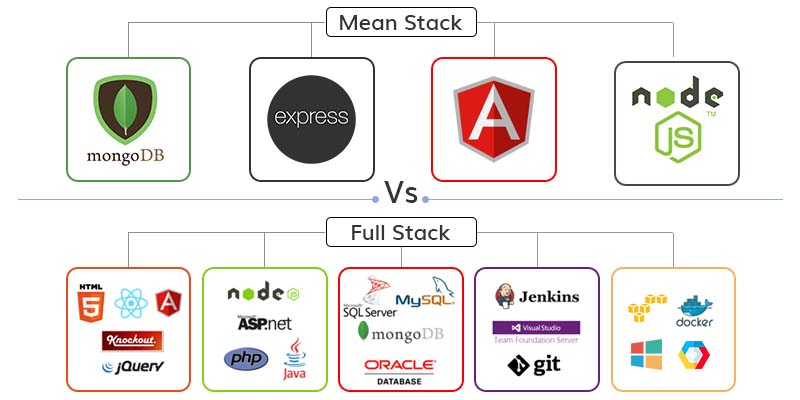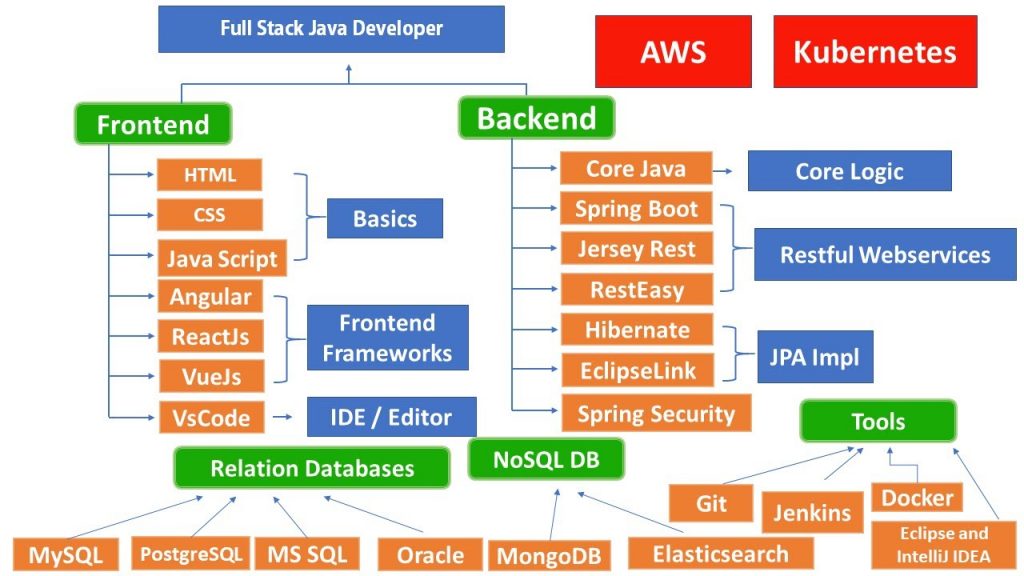Full Stack Developer VS Mean Stack Developer

In a simplified explanation, full-stack refers to the developer (who can develop both the frontend and the backend), while MEAN is a full-stack JavaScript technology framework.
Full-stack development can be divided into web stack, mobile stack, or native application stack and involves coding, databases, servers, and platforms. MEAN stack is for JavaScript developers only. However, both are popular bundles for developers without the scope and purpose of the application. They both provide end-to-end development.
These terms are often confusing for beginners. So, we thought it would be ideal to have an article dedicated to making you understand the differences between a full stack developer and a MEAN stack developer.

What is a technology stack?
It is a combination of a data technology infrastructure collection of all technology services used to create and run an application, websites, mobile applications, and standalone desktop software, from start to finish.
Who is a Full Stack Developer?
To fully understand a MEAN stack developer, it is suggested to start with full-stack development. The websites you view and access have two functional sides. The viewable side is called the user interface that you can see and use and the other side is where all backend data processing and retrieval happens.
For a website to function properly and for its users to get things done, these two parts must work together. IT MEANS that the front end and the back end of the websites need to be optimized for greater efficiency.
When it comes to web development, few professionals specialize in achieving success in these two aspects. These experts are called full-stack developers.
Simply put, full-stack development refers to the development of both the client-side and the server-side aspects of a website. The professionals who do this are called full-stack developers.
The key aspects they are working on include:
- Interface
- Database
- Debug websites and applications
- Back end
Full Stack Developer Responsibilities
- Design the general architecture of the web application.
- Maintain quality and ensure responsiveness of applications.
- Work with the engineering team to design and release new features.
- Maintain the code.
- Experience working with graphic designers and converting designs into images.
- Understand and implement security and data protection.
- Create new features for users and clients, and for internal use.
- Work with the data team to make the product more interactive to use.
Who is a MEAN Stack developer?
A MEAN stack developer, on the other hand, is very different (although they can look deceptively similar). A MEAN stack developer also works on the frontend and backend of a website.
But the only difference here is that whereas a full-stack developer is someone who knows all frameworks, development tools, and programming languages, a MEAN stack developer is only exposed to a limited number of tools.
This includes:
- MongoDB for M
- Express.js for E
- AngularJS for A
- And NodeJS for N
MEAN Stack Developer Responsibilities
- Creation of interactive consumption data from multiple systems
- REST abstraction in the user interfaces through a Node.js backend.
- Team up with engineers, researchers, and data implementation specialists. They will help design and build advanced, elegant, and efficient systems.
- Hands-on experience and handling of Node js, Mongo DB, Angular js, and Express js.
- Design, develop, test, and deploy robust products that are responsive for all device types and fast.
- Design and develop large and complex databases. They are relational and non-relational.
- Establish and use development environment software and tools as needed.
Similarities Between Full Stack and Mean Stack
There is a great demand for these two areas of expertise. While full-stack developers have improved their knowledge, their counterparts are more aware of JavaScript-related projects. For this reason, both will be beneficial to the business.
The mean stack is part of the full stack. Therefore, it will be important that you practice the mean stack correctly in case you want to become a full-stack developer.
1. Framework and programming languages
Full Stack
A full-stack developer knows all the web development frameworks, tools, and programming languages required to develop a fully functional website.
Mean Stack
MEAN stack development is an integral part of full-stack development. A MEAN stack developer is familiar with all four development tools and frameworks.
2. Name and usage
Full Stack
When you say full stack, you are generally referring to the developer.
Mean Stack
MEAN stack generally refers to its acronym, which itself is a full-stack frame.
3. Skillsets
Full-Stack Developer

When you hire a full-stack developer, you have an ideal situation. An ideal full-stack developer should have the following skills:
- Have a deep knowledge and understanding of HTML and CSS.
- Understand JavaScript.
- Have practical experience working with backend languages such as Python, PHP, RUBY / RAILS, SQL, Java, and more.
- Have practical knowledge of databases and web storage.
- Know the web architecture and its concepts. These include file separation and storage, data structuring, code structuring, etc.
- Hands-on experience with Git and profile on GitHub.
MEAN Stack Developer
If you are looking to hire a MEAN stack developer for your team, here are some of the skill sets to look for. A MEAN stack developer typically needs:
- Works in both backend and frontend processes.
- Have a good understanding of design guidelines and programming models.
- Understand the architecture of the database.
- Get comfortable with CSS and HTML.
- Knowledge of other aspects like cloud technologies and architectures, continuous integration, and web design.
- Ability to develop applications/websites within the agile development framework
- Have an understanding of software development cycles.
- Have experience in MEAN tools and frameworks and more.
Benefits of a Full Stack Developer
Full-stack development offers its own unique set of benefits for your projects like the following.
In this, it is easier for a full stack developer to switch between backend and frontend development depending on the requirements of their project.
Full-stack development does not limit its developer to a single particular set of development frameworks or aspects. You can use a full-stack developer to perform a variety of tasks, from web development to layout structuring and more.
Full-stack development is very cost-effective. You don’t have to hire independent developers for frontend and backend development.
In this, a full-stack developer can easily take over all your project processes.
Full-stack developers find it easier to switch to the latest tools and trends in their niche. It is ideal for small and medium-sized businesses.
Benefits of a MEAN Stack Developer
When it comes to MEAN stack development, you get the following benefits:
MEAN stack development allows you to develop websites/applications faster and in an easier way. Developers have to code both the frontend and backend aspects once in JavaScript.
If your MEAN stack developer has written code in one framework, you can easily transfer or migrate the code to another framework with the MEAN stack.
Once you’ve finished designing your website or application, the MEAN stack makes it easy for you to test your output in the cloud.
Similar to full-stack development, the MEAN stack is also cost-efficient. This is mainly due to lower developer requirements and the availability of open-source frameworks and tools. The MEAN stack also simplifies real-time product demonstrations.
Conclusion
We think this article would have given you a detailed perspective on what full stack and MEAN stack development is and their respective developers. The more you know about what you are getting into as a business owner, the more capable you will be of overcoming obstacles.
But if all of this seems too intimidating and you intend to hand all these responsibilities over to one team, you should turn to a full development company like Novateus. We are also a MEAN stack development company, which means we meet all your generic and specialized web and application development requirements.

